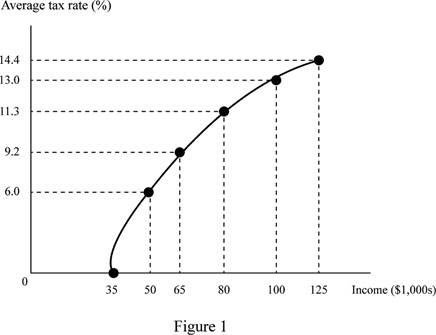
Calculate the average tax rate and identify the tax in nature.
Explanation of Solution
The average tax rate can be calculated by using formula as follows:
Substitute the respective values in Equation (1) to calculate the average tax rate for the total income $35,000 as shown below:
The average tax rate for the total income $35,000 is 0.
Table-1 shows the values of the average tax rate for different income groups obtained by using Equation (1).
Table-1
| Total income |
Average tax rate |
|
$50,000 |
6.0% |
|
$65,000 |
9.2% |
|
$80,000 |
11.3% |
|
$ 100,000 |
13.0% |
|
$125,000 |
14.4% |
From table-1, it is clear that the tax is progressive in nature. There is no tax for the first $35,000. When the income rises, the tax rate also rises.
Figure-1 represents the graphical representation of the average tax rate of these different income levels.

In figure-1, the horizontal axis shows the income levels and the vertical axis shows the average tax rate. When the income rises the average tax rate also rises. Therefore the tax is progressive in nature.
Progressive tax: The progressive tax refers to the higher income people paying a higher tax amount than the lower income people.
Want to see more full solutions like this?
Chapter 19 Solutions
Principles of Economics (12th Edition)
- You are the manager of a large automobile dealership who wants to learn more about the effective- ness of various discounts offered to customers over the past 14 months. Following are the average negotiated prices for each month and the quantities sold of a basic model (adjusted for various options) over this period of time. 1. Graph this information on a scatter plot. Estimate the demand equation. What do the regression results indicate about the desirability of discounting the price? Explain. Month Price Quantity Jan. 12,500 15 Feb. 12,200 17 Mar. 11,900 16 Apr. 12,000 18 May 11,800 20 June 12,500 18 July 11,700 22 Aug. 12,100 15 Sept. 11,400 22 Oct. 11,400 25 Nov. 11,200 24 Dec. 11,000 30 Jan. 10,800 25 Feb. 10,000 28 2. What other factors besides price might be included in this equation? Do you foresee any difficulty in obtaining these additional data or incorporating them in the regression analysis?arrow_forwardsimple steps on how it should look like on excelarrow_forwardConsider options on a stock that does not pay dividends.The stock price is $100 per share, and the risk-free interest rate is 10%.Thestock moves randomly with u=1.25and d=1/u Use Excel to calculate the premium of a10-year call with a strike of $100.arrow_forward
- Please solve this, no words or explanations.arrow_forward17. Given that C=$700+0.8Y, I=$300, G=$600, what is Y if Y=C+I+G?arrow_forwardUse the Feynman technique throughout. Assume that you’re explaining the answer to someone who doesn’t know the topic at all. Write explanation in paragraphs and if you use currency use USD currency: 10. What is the mechanism or process that allows the expenditure multiplier to “work” in theKeynesian Cross Model? Explain and show both mathematically and graphically. What isthe underpinning assumption for the process to transpire?arrow_forward
- Use the Feynman technique throughout. Assume that you’reexplaining the answer to someone who doesn’t know the topic at all. Write it all in paragraphs: 2. Give an overview of the equation of exchange (EoE) as used by Classical Theory. Now,carefully explain each variable in the EoE. What is meant by the “quantity theory of money”and how is it different from or the same as the equation of exchange?arrow_forwardZbsbwhjw8272:shbwhahwh Zbsbwhjw8272:shbwhahwh Zbsbwhjw8272:shbwhahwhZbsbwhjw8272:shbwhahwhZbsbwhjw8272:shbwhahwharrow_forwardUse the Feynman technique throughout. Assume that you’re explaining the answer to someone who doesn’t know the topic at all:arrow_forward
 Economics (MindTap Course List)EconomicsISBN:9781337617383Author:Roger A. ArnoldPublisher:Cengage Learning
Economics (MindTap Course List)EconomicsISBN:9781337617383Author:Roger A. ArnoldPublisher:Cengage Learning









